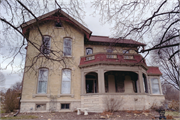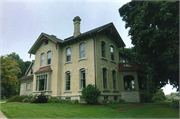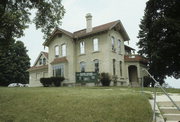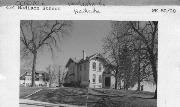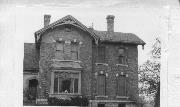| Additional Information: | A 'site file' exists for this property. It contains additional information such as correspondence, newspaper clippings, or historical information. It is a public record and may be viewed in person at the Wisconsin Historical Society, State Historic Preservation Office.
The Blair House was constructed by Samuel Dodd who was one of the leading contractors in Waukesha from approximately 1867 to the 1890s. Dodd was born in England in 1840 and emigrated to New York in 1863. He initially worked as a carpenter and contractor in 1867 and is listed as an architect in the 1890 Waukesha City Directory. He erected a number of important buildings in Waukesha, including the NorthWestern Depot and structures at the Industrial School and Carroll College.
Located on a prominent hill a block northwest of downtown Waukesha, the Blair house is a fine Italianate style, brick dwelling. The building rises two stories above a stone water table and foundation and is asymmetrically composed, with one story porches, a bay window and a one story wing (to the northeast) contributing to the irregular plan. The interesting gable roofs of the two story section of the building are decorated with cusped bargeboards. Windows appear in regular rows and are surrounded by brick frames which are surmounted by segmentally arched heads. Further ornamentation includes stone sills and keystones, the latter with incised patterns. The building was later occupied by the Family Practice Clinic, the Blair house was been remodeled with windows replaced and porches partially enclosed. In 1977, a one story addition was appended to the garage wing. This area served as examining rooms.
Distinguished by fine masonry work as well as high quality ornament, the Blair house is architecturally significant as an example of a period of construction and is a visual landmark in Waukesha. The Blair house shows the influence of the Italianate style and is an important corollary to other cream brick residences constructed in the 1870s-1880s, many of which appear more cubical and contained than this design. See: Moore House, 307 E. Main St. (WK 42/14); Frame House, 507 N. Grand Ave. (WK 1/15); Street-Waite House, 348 Wisconsin Avenue (WK 4/24). The interior of the Blair house has been remodeled but historic features remain intact.
This building is historically significant because of its association with William E. Blair, pioneer industrialist and businessman. Blair, a native of Dundonald, Ayrshire, Scotland, was born on July 31, 1820. He arrived in Prairieville in 1845 trained as a machinist. He entered into partnership with one Amos McLachan to produce agricultural implements. He opened a foundry in 1851 and purchased W.D. Bacon's machine shop in 1853. The Blair Foundry was the largest industry in the Village during this period. In 1855, Blair was one of the founders of the Waukesha County Bank, and, in 1866, became its president. In 1866, he founded the large woolen mill called the Waukesha County Manufacturing Company of which he also remained President until his death in 1880. During his life he was the most prominent businessman in the city. He was also politically active serving five terms as Village Trustee, four terms as Village President and three terms as State Senator. In 1876, Blair built his hilltop home but was only able to enjoy it for three years before his death on July 13, 1880 at the age of 60. The period of significance for the Blair house is 1877 to 1880, the years Blair lived there. Although this structure only served as Blair's residence for the last three years of his life, it is nominated for its association with him as the last reminder of his career. Both the foundry and the woolen mill have long since been demolished. The Waukesha County Bank building associated with his presidency was demolished in 1902 to make room for the present structure and his original home is believed to have been converted into an attached garage, as shown in the 1922 Sanborn map. Thus, this home remains as the only building clearly and intimately associated with his career in Waukesha. |
|---|
| Bibliographic References: | (A) Zimmermann, #773.
(B) Waukesha Freeman 12/2/1996.
(C) Blair, George, "Old Homes and Their Owners", Landmark, Vol. IV, No. 4, p. 3.
(D) Waukesha Freeman, Vol. XIX, No. 24, June 14, 1877, p. 3.
(E) Portrait and Biographical Record, 1894, pp. 348-349; 841.
(F) Waukesha Freeman, July 15, 1880. |
|---|

